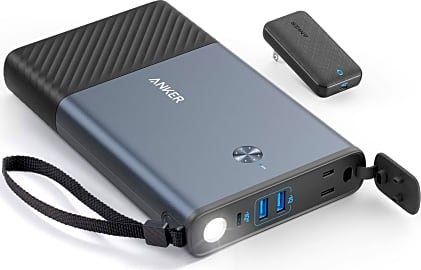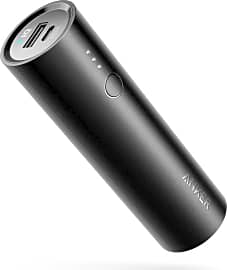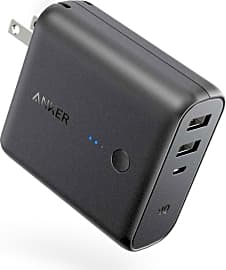The 10 Best Anker Portable Chargers

This wiki has been updated 32 times since it was first published in February of 2017. Founded by a former Google engineer, Anker is now one of the most popular suppliers of power banks in the world. Their PowerCore series has been around for years and is made up of a wide range of models with varying specifications, and they offer multiple other lines suitable for use with many different devices, including smartphones, tablets, full-size laptops, and other electronics. When users buy our independently chosen editorial recommendations, we may earn commissions to help fund the Wiki.
Editor's Notes
December 03, 2020:
Anker remains one of the most trusted manufacturers of power banks, and for good reason. All of their products go through rigorous design and testing phases and are backed by a an above-average 18-month warranty. There are a ton of them to navigate, though, in your search for the right one.
Recently, they have apparently moved away from explicit Qualcomm Quick Charge 3.0 support. One reason for this could be that their PowerIQ 2.0 and 3.0 protocols mimic the charging profile of Qualcomm's popular standard. If your phone or other small electronics are the main things you'll be using it for, the Sense 10K is a great choice due to its reasonable price and slim profile. For something considerably more portable, the PowerCore A1109 is a worthwhile choice. While it's not very recent, it can refill most phones at least once, and it's one of the easiest to fit in your pocket.
The PowerCore III A1617 is especially handy thanks to the integrated wireless charging pad, and the A1362 Hybrid is the one to choose if you don't want to lug around a separate USB hub for your laptop. Speaking of laptops, the Elite A1291 is one of the most versatile models they've ever produced. All four slots can be used at once, and if you only use a single one, it can actually charge a MacBook considerably faster than the stock Apple charger.
Their high-quality products aren't limited to pocket-sized power banks, though. The PowerHouse 100 is one of the smallest and most affordable AC-enabled models available, while its big brother, the PowerHouse II, can power just about all the small electronics you throw at it, due to its high capacity and bevy of ports. Then there's the PowerSolar Flex, which is both highly reliable and flexible for a portable solar panel.
June 17, 2019:
It's hard tell the difference between many of Anker's portable chargers. They offer literally dozens of different models right now, and many of them look similar and cost just about the same, too. You have to wade through quite a few pages of information to gather the specs of each and decide which one is right for you, so we've done that work for you. If you're getting one mostly for your phone or other devices with similarly small batteries, check out the Slim series, as both of those are incredibly convenient. Tablet users and those who frequently don't have access to power outlets should consider the 26800, as it's the biggest one there is, and in fact the biggest one you're allowed to fly with.
In general, you might want to avoid the original PowerCore line, just because it's a bit older and doesn't use the newest controller chip. That's not the case with the PowerCore 1000, though, as its use of the PD standard makes it an excellent choice for iPhone users. The newer PowerCore II is a good one for Android users thanks to its support of Qualcomm's Quick Charge 3 protocol. And if you're looking for maximum portability, the Mini is an incredibly versatile choice. But whichever you choose, you can be certain you're getting a high-quality power bank that should last for years.
Power Of The Past
One important advancement was Carl Gassner's 1886 invention of the dry cell, which eliminated the free-flowing electrolytic medium characteristic of early designs.
Everyone's been there at least once. You're in the middle of an important call, an awesome album, or a hilarious video, and suddenly everything goes dead. Maybe you forgot to charge before you left the house, or maybe your three-year-old laptop battery just isn't what it used to be. But you don't have to cut your tasks short just because you don't have access to a wall outlet.
Originally meaning a set of connected equipment, the term "battery" was first applied to an electric cell by U.S. founding father Benjamin Franklin, in reference to the capacitors he used to aid experiments in pressure and combustion, although this device didn't actually store energy.
Then, in 1780, a dead frog would make an invaluable contribution to the future of humanity. As researcher Luigi Galvani dissected the late amphibian, its leg twitched, leading Luigi to believe that an animal's musculature contained its own stored electricity. He consulted his friend Alessandro Volta, who disagreed rather strongly, and spent the next 10 years proving Galvani wrong. In 1791 Volta published verifiable evidence that two pieces of metal separated by a moist intermediary were capable of producing energy, putting to rest Galvani's animal electricity theory. By 1800, Volta had created the first battery, called the voltaic pile.
What Volta got wrong, though, was his reasoning behind the energy production. He claimed that it was simply the contact between the two metals that caused the electricity, a now-outdated concept called "contact tension." Researchers observed an increase of corrosion on the metals, and that corrosion corresponded with the level of electrical draw. Therefore, it was decided that a chemical reaction must be behind the phenomenon, and such was the birth of modern electrochemical theory.
While Volta laid the groundwork for future electrical engineers, only decades later would practical batteries come into play. One important advancement was Carl Gassner's 1886 invention of the dry cell, which eliminated the free-flowing electrolytic medium characteristic of early designs. Its completely sealed, maintenance-free configuration made it the first battery accessible to the average person, and directly led to the invention of the flashlight. Based on Gassner's work, the National Carbon Company developed the zinc-carbon battery, refined versions of which are still in production today.
The Current Chemicals
Broadly speaking, batteries are in one of two classes: primary or secondary. Primary batteries are charged at capacity as soon as they're assembled. This type runs through their reserves once, and then they're done forever. Needless to say, they're a lot less efficient than the secondary variety, which can restore their potential energy upon reversal of the electron flow. Most people know of these as rechargeable.
Today, Li-ion powers the vast majority of consumer electronics because of its relatively long life and resistance to charging memory or capacity degradation.
Portable electronics have been around for a few decades, and over that time, they've used three main types of rechargeable cells. Nickel and cadmium made up the first alkaline battery in 1899, and the same formula remained in widespread use until the 1990s. Due to their low voltage and sensitivity to charging patterns, Ni-Cds were mostly phased out in favor of nickel-metal hydride and lithium-ion batteries. Today, Li-ion powers the vast majority of consumer electronics because of its relatively long life and resistance to charging memory or capacity degradation.
Inside a lithium-ion cell are two chambers filled with a water-based, electrolyte solution. Keep in mind that one battery can consist of multiple cells. On either end of the battery, an electrode extends from the exterior to the interior, where it terminates in an anode or cathode. The charged lithium ions, i.e. the ones that posses an extra electron, are all huddled around the anode. When delivering power, the electrons part ways with the lithium and travel down the anode and out of the battery to the electronic device. Now the lithium clings to the cathode, where it awaits its time on a charger. Charging simply reverses the flow of electricity, allowing free electrons to mate with Lithium ions, which then cross the internal separator to rest on the anode, charged and ready for action.
Extending Battery Life For Everyone
Today's electronics are so versatile and powerful that we use them nearly all day long. Not surprisingly, it's pretty easy to forget a single charging session and end up without Instagram access hours before the night ends. Or if you're busy finishing your screenplay in a packed Starbucks and can't find an outlet, you shouldn't have to stop working on your masterpiece. There are more ways to keep your phone or laptop running than ever before.
Since then, the firm has centered its focus on smartphone power accessories, and have racked up incredible sales in that field.
Before you label Anker as just another low-overhead, Chinese-imported off-brand, know that it was founded in California by Steven Yang, at the time one of Google's senior engineers. The next year, Yang moved to China just to be closer to the supply chain and take further responsibility for his company — a pretty high-integrity move in today's profit-beats-all corporate world. Since then, the firm has centered its focus on smartphone power accessories, and have racked up incredible sales in that field. It took a little while, but the upstart supplier has even edged its way into big-name stores like Best Buy and Microcenter.
They offer an excellent variety of features and specifications across their broad line of products. Some are built with an ultra-portable bent, and can triple a phone's operating time even though both devices are about the same size. Others act as multi-device chargers with a combination of USB-A and USB-C outputs. Some of these boast the increasingly popular Power Delivery standard, a dynamic current-control method that charges items as large as 2-in-1s, MacBooks, and the Dell XPS 13. It's important to double-check your devices' as well as the charger's specifications, because some electronics have sensitive or restricted charging systems. What you likely won't have to worry about with most of these is defects and shorts; when it comes to Anker chargers, it does appear that "Made In China" is a superlative.















